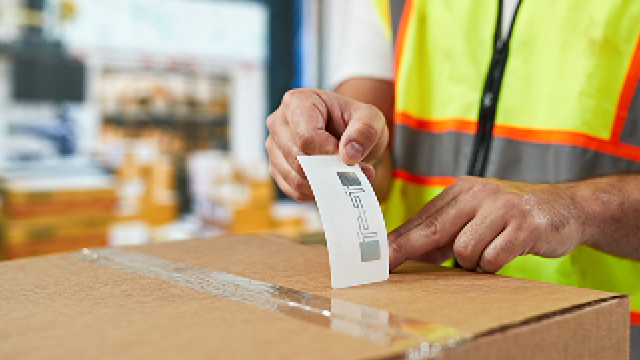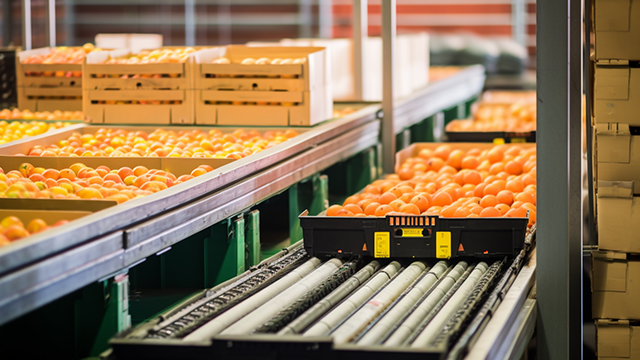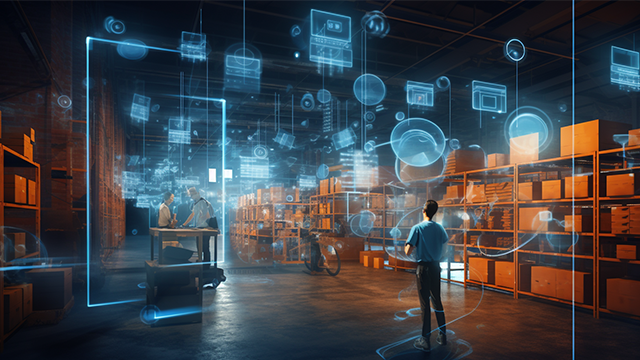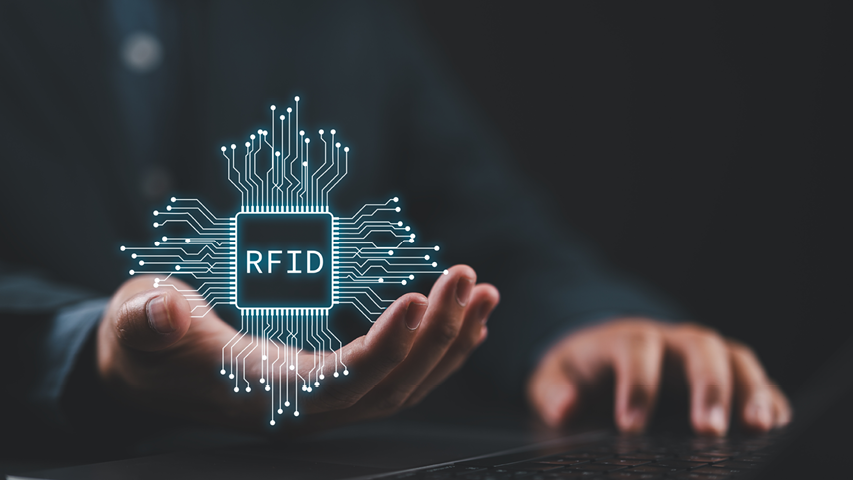Revolutionise the Food Supply Chain with RFID Technology
Help your clients comply with regulations and meet consumer demands for traceability in innovative ways with this familiar technology.
BlueStar's diverse portfolio offers unparalleled access to premium products and services that drive business growth and success. From state-of-the-art hardware to advanced software solutions, our portfolio is designed to empower businesses with the tools they need to thrive in today's competitive landscape.
Our vertical-based content focuses on different industry technologies, solutions, and insights.
A true VAD offers top-notch pick, pack and ship services, and provides programs and services that add value to the distributed products that increase their value or worth.
The BlueStar Difference
RFID solutions give T&L operations visibility, track-and-trace capabilities, efficiency, and accuracy that mitigate losses, control costs, and increase customer satisfaction.
Tracking Cargo and Maintaining Visibility Is Possible with the Right Technology
Transportation and logistics (T&L) companies are challenged to move raw materials, products, or people to their destinations quickly and efficiently – and deliver those services better than the competition.
A Levvel (part of Endava) survey[1] reveals that 70 percent of T&L companies say speed and accurate estimated delivery times (ETD) or arrival times (ETA) are their primary challenges. However, several barriers are standing in the way of improving these areas. Operations are plagued by inefficient processes, lack of skilled labor, high error rates, rising costs, and lack of visibility – both in the warehouse and during transport. Automating processes is the answer to better T&L operation performance KPIs.
Automating Processes with RFID
Operations can automate processes in various ways, but one of the most effective is to automate data collection with RFID technology. IT solutions providers may encounter prospects familiar with RFID tags used in loss prevention or smart cards or fobs as a part of physical access control systems. However, RFID technology has the potential to bring so much more value to T&L operations.
Companies that rely on paper-based processes for recordkeeping and data collection can see impressive productivity gains by replacing them with RFID technology. It decreases the need to assign labor to these tasks and lowers the risk of human error and waste. Paper-based processes also have an inherent lag from the time data is collected until it’s entered into the company’s management system or database. On the other hand, RFID enables real-time data, providing immediate updates to the systems decision makers rely on.
A Range of RFID Solutions that Solve T&L Challenges
One of the benefits of RFID technology for T&L use cases is its long history. The idea of using electromagnetic waves to track objects can be traced back as early as the 1940s[2], and the patent for RFID was filed in 1983. Over the decades that followed, innovators created various ways to leverage the technology and bring costs down, making it a practical solution for a range of T&L use cases.
Although organizations can choose from various RFID solutions, they all include three essential components: RFID tags or labels, RFID readers, and RFID software.
RFID Tags and Labels
T&L operations can encode RFID tags and labels with data, such as where shipments originated, their destinations, proof of compliance screenings, or other essential information. RFID tags and labels have more storage capacity than barcodes, and they are also read/write devices so that they can be updated as vehicles and cargo move between milestones and checkpoints.
RFID labels and tags can also be encrypted so that only authorized users can read or update information stored on them. This feature is particularly valuable for companies that transport high-value items that are targets for counterfeiting. For example, pharmaceutical companies can encode tags and encrypt the data so that only supply chain partners can access the information stored on them.
RFID tags and labels are available in a range of frequencies and types:
T&L companies can also choose between active and passive RFID tags and labels. Active RFID tags contain batteries and transmit signals; passive RFID tags don’t have batteries and are activated by RFID readers.
RFID Readers
Organizations also have the choice of RFID reader form factor, typically from among three types:
RFID Software or Middleware
RFID software sits between RFID readers and business applications to format data from RFID tags so the inventory management system or other applications can use it.
Where T&L Operations Benefit from RFID
RFID has the potential to optimize processes and enhance customer experiences throughout transportation and logistics operations.
Head Office: RFID technology allows managers and business leaders to track inventory remotely and at the item level. When data is managed via blockchain or a distributed ledger, all stakeholders in the supply chain have an immutable, single source of truth to use in planning and decision making.
Manufacturers: Vendors label products with RFID tags or labels, encoding them with vital product information, such as the batch number, for traceability, expiration, or other necessary data. Passive RFID sensor tags can also detect temperature or humidity changes necessary for cold chain or perishables monitoring.
Transport: When checked baggage, shipments, or inventory pass through portals equipped with RFID readers, an operation can automate data collection, streamline processes, and provide accurate tracking data.
Distribution and Fulfillment Center: RFID technology enables operations to automate data collection at receiving, keep accurate inventory data, and quickly locate items.
Last Mile: Delivery drivers can confirm that items are heading to the correct destination and verify delivery.
Real-World Retail RFID Success Stories
A Vehicle Manufacturer Tracks Parts from the Warehouse to Production
RFID automates data collection and enhances productivity.
Freightliner-Western Star Trucks, the leading heavy-duty truck manufacturer in North America, evaluated ways to improve efficiency and accuracy for better cost control. Its existing system required employees to put parts needed for manufacturing into totes, which were then transported to the shop floor via tugs. Empty totes were then returned to the warehouse.
While the system met Freightliner’s needs, data collection was labor-intensive and error-prone.
Must-have features of a new solution included automation to reduce the labor required for inventory handling, tracking and picking and integration with existing asset management databases. The solution also needed to be scalable so that after a successful pilot at the company’s Portland, Oregon, location, it could be rolled out to all locations across North America.
The Solution
Freightliner began with a study that revealed two choke points that every inventory shipment had to pass through when entering or leaving the warehouse. The company deployed advanced Zebra Technologies fixed RFID readers and industrial antennas at each of these portals. The company used metal-mount RFID tags on the tugs that transported the totes and encoded the tags with data per the Global Returnable Asset Identifier (GRAI) format. Large, 4”x6” paper RFID tags were attached to individual totes using GRAI to provide as much exposure as possible for reading as they passed through the scanning portals.
The company chose System Concepts’ TraxWare Software, designed for industrial inventory control, asset tracking, and EPC/DoD compliance. The software also seamlessly integrates with the Zebra RFID hardware that Freightliner selected.
The RFID system identifies each tote and tracks its movement throughout the operation. It generates a receipt of each transaction and automatically sends it to the Freightliner database, providing real-time information on the location of each item.
The deployment began with a proof of concept (POC), which confirmed the business value of RFID and provided insights into the best strategy to roll out full solution deployment.
The Results
Freightliner has seen a direct return on investment (ROI) from the RFID solution, including lower labor costs related to inventory control and decreased errors. Additionally, productivity increased with production lines receiving the correct parts on time.
An International Airport Solves Baggage Handling Challenges
RFID streamlines baggage handling and helps to increase customer satisfaction.
McCarran International Airport has experienced double-digit growth in recent years, now managing more than 460 flights per day and providing transportation to approximately 70,000 passengers. The airport aimed to enhance processes and passenger satisfaction even as traffic scaled. However, legacy baggage processing procedures weren’t adequate to keep up with higher volumes. As a result, airport officials began their search for alternatives to conventional baggage handling and tracking processes.
The Solution
McCarran Airport worked with Zebra Technologies to create an efficient, cost-effective, accurate baggage handling system leveraging RFID technology. The system tracks all bags to align with TSA regulations, tracking them through explosive detection and screenings to ensure passenger safety.
RFID tags are printed and attached to bags at the ticket counter. Each tag is encoded with a unique identifier that RFID readers read as the bag is received, transported to screenings, and then directed to the appropriate plane.
The Results
The RFID baggage tracking system provides McCarran Airport with nearly 100 percent accuracy and end-to-end visibility into baggage. Despite ever-growing traffic, the airport sees increased efficiency, enhances passenger safety, and reduces operating costs.
RFID and Cold Chai
In addition to streamlining inventory movement and asset tracking, RFID technology has the potential to enhance cold chain operations for food and pharmaceuticals. About 14 percent of the world’s food is wasted between harvest and retail.[3] The World Health Organization (WHO) also estimates that 50 percent of the world’s vaccines are lost due to temperature control, shipment, and supply chain issues.[4] RFID technology streamlines processes, increases accuracy, and provides visibility into cargo and environmental conditions, so shipments arrive safe and usable.
However, solution providers need to recognize that RFID solutions must be suited to use in the cold chain to be effective. Devices must work in sub-zero environments and resist damage from condensation as employees move from cold storage to ambient temperature areas. Devices should also be constructed with materials that can withstand temperature extremes and exposure to dust, liquids, vibrations, and other conditions common to industrial and commercial environments. Reliable performance also depends on adequate battery life and device management that provides insights into their performance so businesses can maintain them proactively.
Label choice is also vital. Work with your clients to choose labels that hold up to the cold, moisture, and freezing conditions and adhesives that work in the temperature range in which items are stored or transported.
The Opportunity to Provide RFID Solutions to T&L
RFID technology is proving its value to transportation and logistics companies in many use cases. However, interestingly, it’s not yet widespread. Levvel research shows that although advances in digitalization are most commonly deployed to track inventory or cargo, only about 17 percent of T&L companies are using this technology. Additionally, 50 percent of companies said automation capabilities were “close to 0.”[5]
But analysts predict market growth. For example, Vantage Market Research forecasts that the market will grow at a 9.7 CAGR to reach USD 17.6 million by 2028.[6] Drivers include the demand for real-time visibility, track-and-trace capabilities, safety regulation compliance, theft prevention, and asset management.
Organizations that recognize RFID’s value will be a greenfield for IT solutions providers who can harness this technology’s potential to solve their business problems.
Begin at BlueStar
If you aren’t sure where to begin to provide T&L operations with RFID solutions, start with a call to BlueStar. We provide the most diverse RFID solutions in the industry, including low-frequency, high-frequency, ultra-high-frequency, and active and passive RFID. Experts on BlueStar’s team can help you choose the optimal hardware, software, media, and value-added services to help you design your client’s optimal solution.
BlueStar also offers its partners support through educational opportunities, events, and one-to-one support, to ensure their projects are successful.
T&L companies are waking up to the need to automate processes as they contend with pain points related to labor shortages, rising overhead costs, and increasing customer demands. Show them how RFID technology can solve some of their challenges.
Source:
1Current Challenges in the Transportation & Logistics Industry, Endava, https://www.endava.com/en/blog/Business/2022/Current-Challenges-in-the-Transportation-Logistics-Industry
[2] The History of Radio Frequency Identification Technology, Paragon ID, https://www.paragon-id.com/en/inspiration/history-radio-frequency-identification-technology
[3] FAO: 14% of the world’s food is lost between harvest and retail, global agriculture.org, https://www.globalagriculture.org/whats-new/news/en/33821.html.
[4] Why optimized cold chains could save a billion COVID vaccines, UN environment programs, https://www.unep.org/news-and-stories/story/why-optimized-cold-chains-could-save-billion-covid-vaccines
[5] Digital Automation in the T&L Industry, Endava https://www.endava.com/en/blog/Business/2022/Digital-Automation-in-the-T-L-Industry
[6] Radio-Frequency Identification (RFID) Tags Market to Hit USD 17.6 Million by 2028, Vantage Market Research, https://www.globenewswire.com/en/news-release/2022/06/22/2466919/0/en/Radio-Frequency-Identification-RFID-Tags-Market-to-Hit-USD-17-6-Million-by-2028-Radio-Frequency-Identification-RFID-Tags-Industry-CAGR-of-9-7-Between-2022-2028-Exclusive-Insight-Re.html

Help your clients comply with regulations and meet consumer demands for traceability in innovative ways with this familiar technology.

RFID is a familiar technology, but TSPs are finding innovative ways to use this technology to solve their clients’ pain points and provide value.

Why RFID Is EMEA’s Hottest Tech Opportunity – Now and For Years to Come